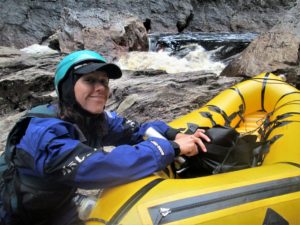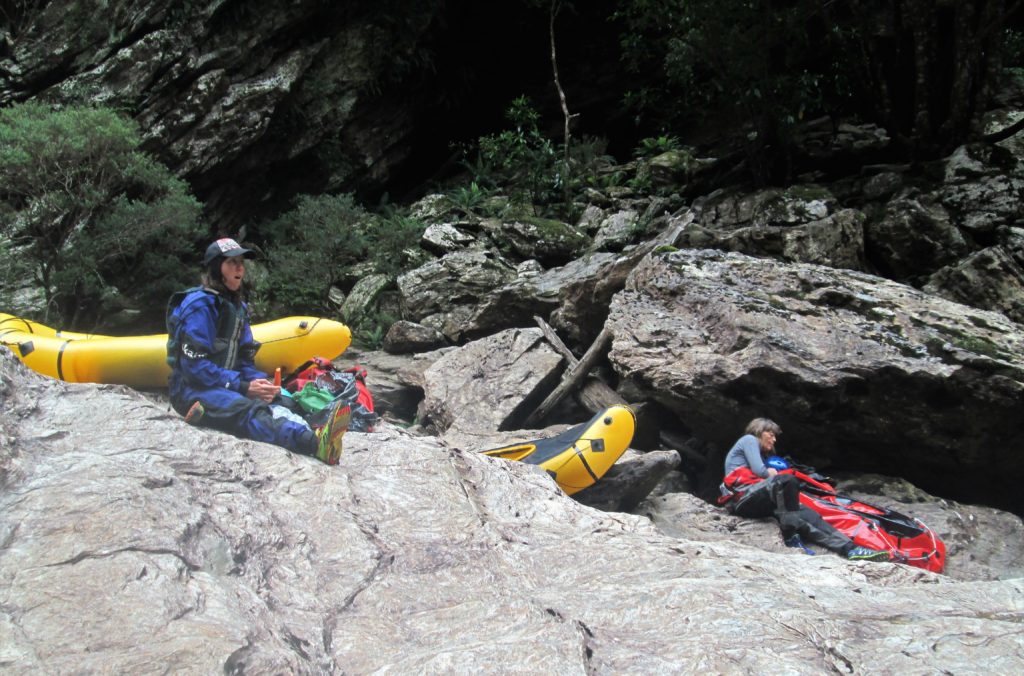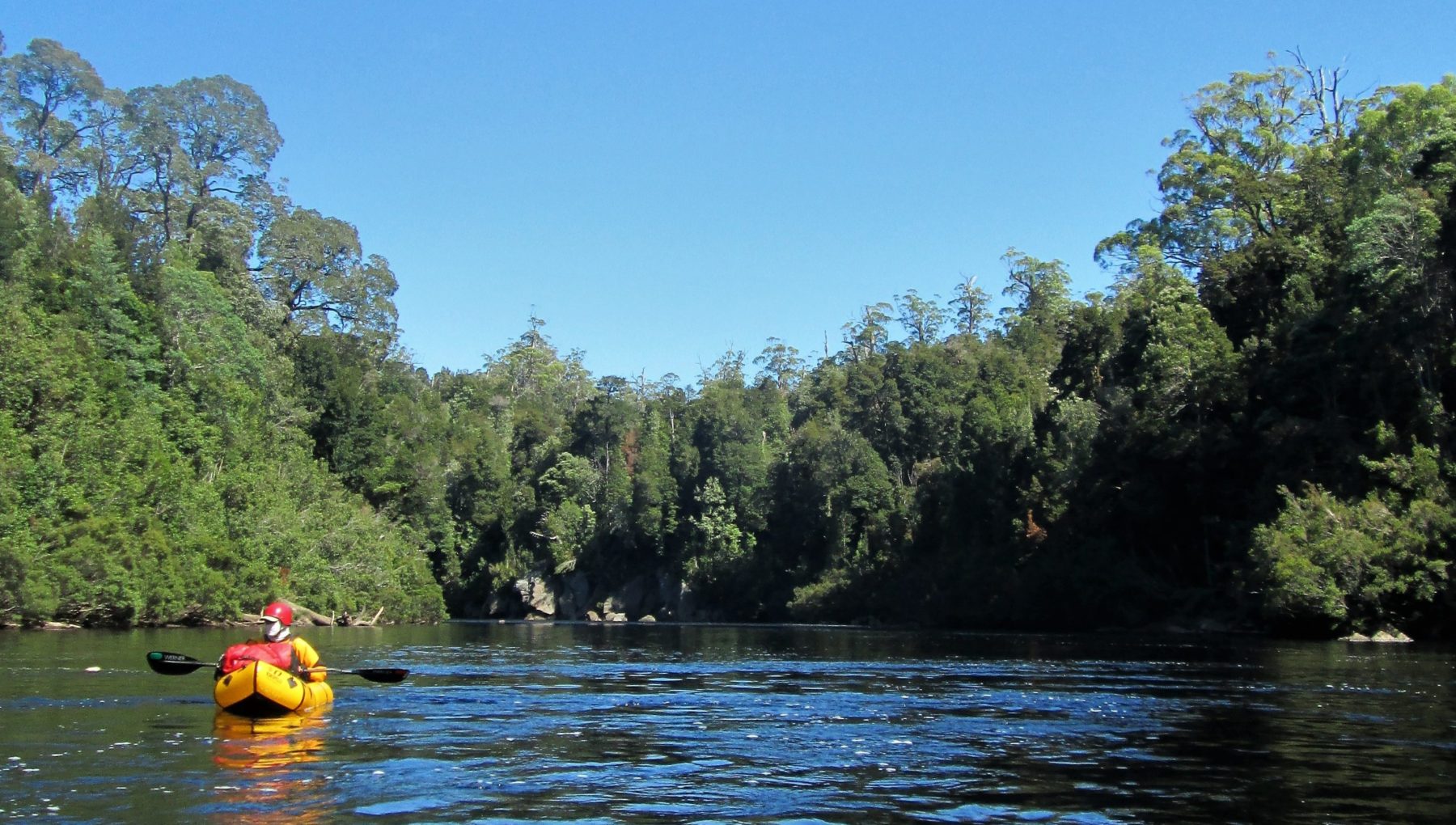
I can still taste the dread that swaddled me upon our arrival at the boat launch. We had anticipated the Franklin River packrafting trip for months and my sense of eager anticipation only grew during the misty, winding trip into the mountains toward the Collingwood River Bridge. I remember how the joy of seeing more echidnas in that three-hour drive than I had seen in an entire year in mainland Australia was suddenly snatched from my chest and replaced with fizzy, churning anxiety.
The catalyst of my fear was an interpretive sign at the boater self-registration kiosk announcing the hazards that lay ahead of us—strainers, class IV+ rapids and wildly fluctuating water levels. The take-away was that the Franklin River through the Tasmania Wilderness World Heritage Area was decidedly not a good place to learn whitewater skills, which was precisely what I planned to do. Since the extent of my previous paddling experience amounted to piddley class I and flatwater, I very nearly bailed on my friends and hitch-hiked back to Hobart. Instead, I gritted my teeth and trudged down to the Collingwood to inflate and rig my Kokopelli packraft, afraid that death was imminent.
If not death, then certainly embarrassment. I pictured the comedic storyline that would surely befall our trip: four suave, professional whitewater rafting guides and me, a bona fide boating dunce, falling out of her boat, swimming the biggest rapids, losing her paddle and getting stuck in every hole. Slap-stick comedy certainly cast a lighter tone on my ineptitude and with that in mind I paddled downstream.
Rain on the Collingwood River
Our four vibrant red and yellow boats—three packrafts and one 11-foot raft—were in stark contrast to the river, which looked more like bitter black tea than a world class wilderness waterway. My boyfriend floated beside me, offering some last-minute coaching in whitewater skills from his slick skirted Kokopelli. The float toward our first camp at the confluence of the Collingwood and Franklin passed uneventfully, and I successfully navigated several shallow riffles and Sticks and Stones, the trip’s first named rapid.
It rained that night and most of the next day. We spoke in hushed tones about the feature for which the Franklin is most famous—its tendency to rise to unrunnable levels in a matter of hours, sometimes stranding boaters at camp for days. As the rain continued, I felt keenly aware that we had left the last easy hiking trail out of the canyon behind us that morning.
I reminded myself that we were well-prepared to wait out any lasting high water. Our boats were loaded with enough food for 14 days, all of which fit neatly into the zippered compartment in our packrafts’ tubes. This stowage helped keep the center of gravity on the packrafts low, while also giving us the flexibility to wait out high water for up to six days, if necessary.

High-Water
As we reached the potential portage at Nasty Notch, the reality of our high-water strategy set in. With the water rising steadily, we opted to set up camp above the Notch and wait out the rising tide before heading into the fabled Descension Gorge below. However, the prospect of spending several days at Nasty Notch was far from appealing. The campsite—like many along the Franklin—sat on a narrow shelf between the raging river and the steep, slippery, impenetrably-forested slopes of the canyon. While I had previously fantasized that waiting in camp would offer opportunities to explore from the safety of solid ground, it was becoming apparent that sit-and-wait would entail, quite literally, sitting and waiting. At least, I thought, We have our tents to shelter us from the hoards of leeches.
Much to our relief, the water dropped several feet overnight, exposing a massive boulder in the middle of Nasty Notch that had been entirely hidden by a pour-over the night before. We continued downstream, thrilled to have glimpsed the river’s feisty side, but still cautious about the weather and other obstacles ahead.
The Depths of Franklin Canyon
Most of the next week blends together in my mind. Persistent rain and fog cast the landscape in austere tones, but the rivers’ flow remained relatively constant. I was as grateful for my drysuit’s protection from the weather as I was for its buffer against the soaking spray of rapids. The rain forced us to skip the hike to Frenchman’s Cap, due to the sodden, slippery trail and the likelihood that the top was socked in. We made numerous gnarly portages around gnarlier rapids, floated through quartzite canyons, and slept on beaches and shelves never more than 50 feet from the river.
Several memorable swims provided the main punctuation. Although my whitewater skills still lagged far behind my experienced companions, I was quickly becoming an expert in self-rescue. Several times I fell out of my boat and climbed back in before anyone noticed—private blunders that I imagined added to the comedic storyline.
Unlike the others, I looked forward to the portages, which offered a welcomed respite from my white-knuckled paddling. I felt comfortable enough on land that I finally could enjoy the dramatic cliffs and booming whitewater stereo, as we portaged around violent, unrunnable rapids. Dancing across slick boulders and charging up muddy slopes with my packraft on my back, I finally felt like a worthy participant in this adventure. The portages themselves appeared arduous in length and topography, but were simplified with a packraft. For the longer overgrown trails high above the river, I made two trips—one for the boat and a second for my gear. For the shorter routes along the shore, I could simply hoist my fully-loaded boat on my back and complete the trek in one trip.
The Crux of the Great Ravine
The turning point in my whitewater bildungsroman came at a class IV+ rapid called Thunder Rush. In fact, Thunder Rush is only rapid I remember in any detail, given that I ran most of the others with panicked tunnel vision. The canyon around Thunder Rush was vertical on both sides without a possible route to avoid a big drop tailed by an intimidating boulder garden.
I remember standing on the shore, feeling inexplicably calm as I watched the 11-foot raft push off in front of me and immediately flip, sending its two experienced paddlers swimming straight into the boulders below. Perhaps buoyed by the fallibility of even these professional rafters, for the first time on the trip, I accepted that I would never have complete control of my boat. Instead, it became clear that successful boating involved positioning myself to minimize the chaos the river threw at me, and reacting as best I could to the ensuing mayhem.
The Run
I took several deep breaths and quietly steeled myself for an epic swim before pushing off. This ability to cultivate a calm mind amidst a bodily flood of adrenaline must be why my friends invited me on this trip, I thought, as my packraft accelerated toward the drop. Locked in tight with my thigh-straps I slid over the drop and landed squarely in the hole beneath. I felt that familiar grip of the hole on my packraft and leaned hard downstream. Miraculously, I broke free and found myself careening backwards toward the boulders.
I let out a loud whoop of celebration before turning my nose downstream to navigate the boulders. In a stroke of either brilliance or luck, I managed to grab my friend’s stray paddle that was caught in an eddy as I successfully exited the boulder garden. I smiled for what felt like the first time in days.
The Real Crux – Sir John Falls to Heritage Landing
The next morning we saw the sun for the first time on the trip. Soon thereafter, we were below the wildest rapids and into a stretch of river that I would have found easy even before my success at Thunder Rush. Eventually, the Franklin flowed into the larger Gordon River and we floated past a dock at Sir John Falls, where—had we been less worried about potential delays due to high water—we could have set a date to be picked up by a charter sailboat.

Instead, we resigned ourselves to paddling 13 miles of flatwater to Heritage Landing, where we planned to meet a daily tourist cruise ship that would bring us back to the town of Strahan. After several uneventful miles, the river—500 feet wide at this point—straightened and aligned itself perfectly with a stiff headwind that made forward progress futile.
We navigated toward a small sandy beach, which was the only land not covered in thick forest for several miles in either direction. The beach teamed with March flies, but our tents gave respite enough for a nap before we resumed paddling after sunset when the wind abated. Moral was low as we paddled toward Heritage Landing, especially since the imagined alternative to our nocturnal paddle was an afternoon of lounging on that charter sailboat from Sir John Falls.
After many hours of hugging the shore and craning our headlamps into the surrounding forest, fearful of paddling straight past Heritage Landing, we arrived. A final bout of rain settled in as we pitched out tents on the boardwalk of an interpretive trail, since the dense vegetation and mud prevented camping elsewhere. As we drifted to sleep to the torrents of rain pummeling our tents, it felt as though the river were bidding us good riddance.
Cruising the Gordon River
Stepping on to the Strahan-bound 190-passenger cruise ship the next morning was undoubtedly the most shocking post-adventure reintroduction to society I have ever experienced. After nine days of social confinement to my four companions and the wild Franklin I felt (and surely smelled) like a zoo animal in comparison to the ship’s mostly elderly, wealthy clientele. Despite the fact that we had plenty of leftover trip food, we each made several visits to the cruise’s buffet, eager for salad and chicken after days of cheese, peanut butter and trail mix.
By the time we arrived in Strahan, where we would hitch-hike back to our vehicle at put-in, the trip was already starting to feel like a surreal, foggy dream. Arriving back at the Collingwood River Bridge, I glanced at the sign warning about the dangers of a Franklin River rafting trip. I remembered how anxious I had felt the last time I stood in front of this sign and now understood just how justified that fear had been.
While a more prudent version of myself would have chosen something easier than the Franklin for her first packrafting trip, I did not have any regrets. The trip had opened up a new medium of adventure–one that had the potential to take me deep into some of the world’s most rugged wilderness areas. I stood in front of the sign smiling, feeling fortunate that its forebodings went unrealized. But most of all, I smiled because I was already planning my next packrafting adventure.